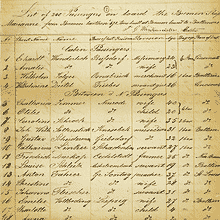German emigrant database
The German Emigrant Database (DAD) at the Historical Museum Bremerhaven is a research project on European emigration to the United States of America . The database contains information on people who emigrated to the USA between 1820 and 1939, primarily via German ports. The aim is to make the collected data accessible to historical and social science research. The DAD also enables research into emigrated ancestors. The DAD is financed through donations, sponsors and research fees. The proceeds will be used in full to further develop the database. The DAD is run by the non-profit sponsoring group Historisches Museum Bremerhaven e. V.
Passenger lists
The recorded data is based on the passenger lists of the emigrant ships . These lists had to be presented to the American immigration authorities upon arrival in the USA. The level of detail of the data recorded varied according to the requirements of American immigration policy. At the beginning of the 19th century, 14 pieces of information about the respective immigrants were recorded on the passenger lists, at the beginning of the 20th century there were already 40 Ports of arrival and arrival date in the USA are recorded. In the German emigrant database, the passenger list data is supplemented by other sources such as documents and civil status registers.
Passenger lists in the USA have been recorded electronically since the 1980s. The Center for Immigration Research at the University of Philadelphia / Pennsylvania was in the lead here. From there, the German Emigrant Database received the extensive total data for the years 1850 to 1891. Since 1999, the DAD has been involved in the electronic compilation of passenger lists made available by the National Archives of the USA. The German emigrant database is still under construction. It currently includes the data of around 5 million emigrants. The periods from 1820 to 1897, 1904 and 1907 are recorded.
Data quality
The passenger lists are handwritten forms that have been handed down in different quality. Legibility can be impaired by damage to the paper, illegible handwriting, deletions or corrections. In addition, the entries can sometimes not be clearly assigned to a person. Often the information is based on verbal information from the passengers, so that the American officials could have hearing errors, misunderstandings or intentional changes (Americanizations).
Research
Visitors to the Historisches Museum Bremerhaven can personally search for emigrated passengers in the database at two terminals in the exhibition rooms. It is also possible to place a research order with the German Emigrant Database. Since December 2007 it has been possible to search for emigrants independently via the Internet. Fees are charged for research assignments. As a result of the research, the user receives a certificate for each person found with the surviving data of the emigration.
literature
- Anja Benscheidt / Alfred Kube (Hg./Ed.): The German Emigrant Database. Passenger lists as a research source , Bremerhaven 2006 (Historisches Museum Bremerhaven. Kleine Schriften, Volume 7).
- Anja Benscheidt / Alfred Kube: Bridge to Overseas. Emigration via Bremerhaven 1830–1974, Bremerhaven 2006 (Historisches Museum Bremerhaven. History in Pictures, Volume 4).
- Alfred Kube: The German Emigrant Database. Migration research at the Historisches Museum Bremerhaven. In: Uwe Lissau (Ed.), District Court in Bremerhaven. History and present. Contributions from justice, research and monument preservation, Bremerhaven 2006, pp. 73–98.


